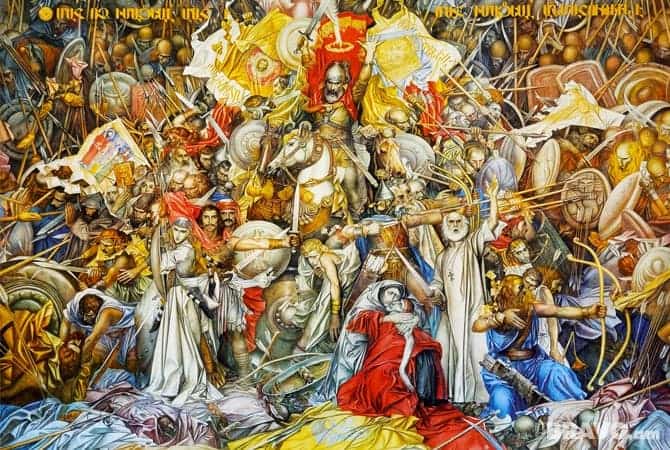Death of Grigor Khanjian (April 19, 2000)

 The tapestry representing the Battle of Avarair, with Vartan Mamikonian holding the sword tall and many familiar faces of Armenian contemporary culture among the fighters (even William Saroyan is there), is one of painter and illustrator Grigor Khanjian’s best known works, whose original is exhibited in Holy Echmiadzin,
The tapestry representing the Battle of Avarair, with Vartan Mamikonian holding the sword tall and many familiar faces of Armenian contemporary culture among the fighters (even William Saroyan is there), is one of painter and illustrator Grigor Khanjian’s best known works, whose original is exhibited in Holy Echmiadzin,
Khanjian was born in Yerevan, on November 29, 1926, the child of genocide survivors. In 1945, he finished the coursework at the Panos Terlemezian Art College and entered the Academy of Fine Arts at the age of nineteen. He mostly studied under the guidance of painter Eduard Isabekian, a prolific artist, whose influence on the early works by Khanjian was strong.
Khanjian never joined the Communist Party, despite the logical pressure to do so in order to advance a career, opting often for national instead of Soviet subjects. For example, for his graduation work in 1951, he chose the topic of the 1907 Communist Congress in London, but pictured Stepan Shahumian next to Lenin instead of Joseph Stalin, as it would have been expected. In 1965, he sent his illustrations of Paruyr Sevak‘s poem The Unsilenceable Belfry, with a subject centered on Gomidas Vartabed and the Armenian Genocide, to the all-Soviet exhibition of graphic art. Incidentally, in 1969, he earned the State Prize of the Soviet Union for those illustrations.
In 1953, he entered the Painters Union and had a fast career. He first earned the title of Emeritus Painter of Armenia (1961), then Emeritus Art Worker (1963) and Popular Worker (1967). He was also elected corresponding member (1963) and, a decade later, full member of the Academy of Art of the Soviet Union. Much later, in 1982, he became corresponding member of the Academy of Sciences of Armenia, and, in 1990, full member.
Khanjian was elected deputy to the Supreme Soviet of Armenia and member of the Presidium in 1975. He earned the title of Popular Artist of the Soviet Union in 1983 and was designated honorary member of the Academy of Art of Russia in 1990.
In 1966 he had joined the Supreme Spiritual Council of Holy Echmiadzin and befriended Catholicos Vazken I. He created large-scale tapestries depicting episodes from Armenian history like the Battle of Avarayr and the creation of the Armenian alphabet. As the tapestries were held in the Catholicosate buildings, where common people could not enter, Khanjian was asked by Karen Demirchian, then the head of the Armenian Communist Party, to reproduce the works as murals at the newly finished Yerevan Sport and Music Complex (Hamalir). Instead, Khanjian created “Mother Armenia,” the second largest theatrical curtain in the Soviet Union, for the Complex and made the murals at the Yerevan Cascade (now Cafesjian Museum of Art, then still under construction). Further, he added a third part, “Rebirth of Armenia,” turning the murals into the triptych “History of Armenia.”
He passed away on April 19, 2000, in Yerevan. The Cafesjian Museum of Art has named one of its main exhibition halls after Grigor Khanjian, and, in 2016, the Central Bank of Armenia issued a commemorative coin featuring Khanjian tapestry of the Battle of Avarayr. Among his works of woodcarving are the decorated doors of the Alex and Marie Manoogian Museum in Southfield, Michigan, and the furniture of the Armenian Classroom of the University of Pittsburgh. His frescoes are found in Holy Echmadzin, St. Vartan Cathedral, New York, the Armenian Patriarchate of Istanbul, and other churches.
